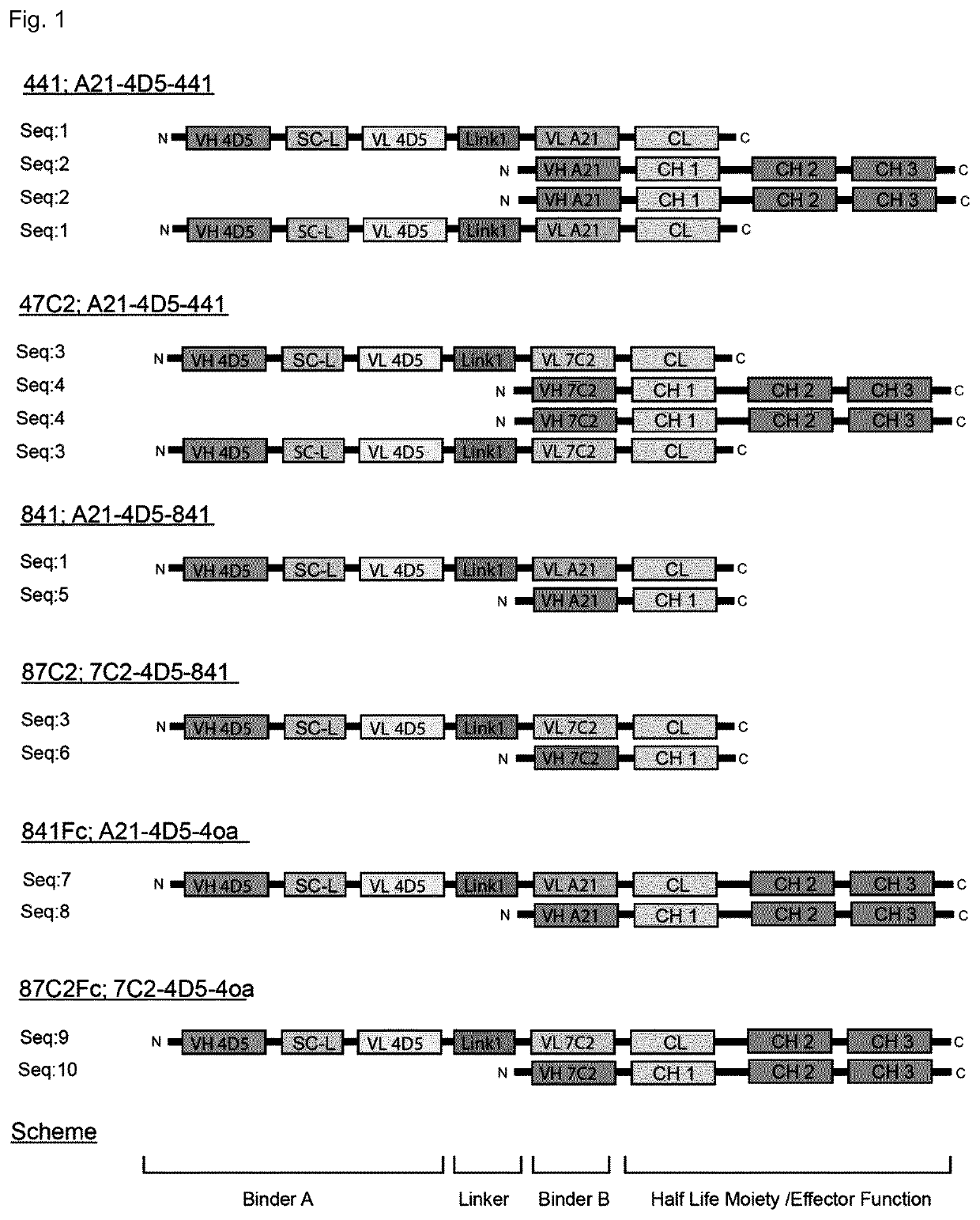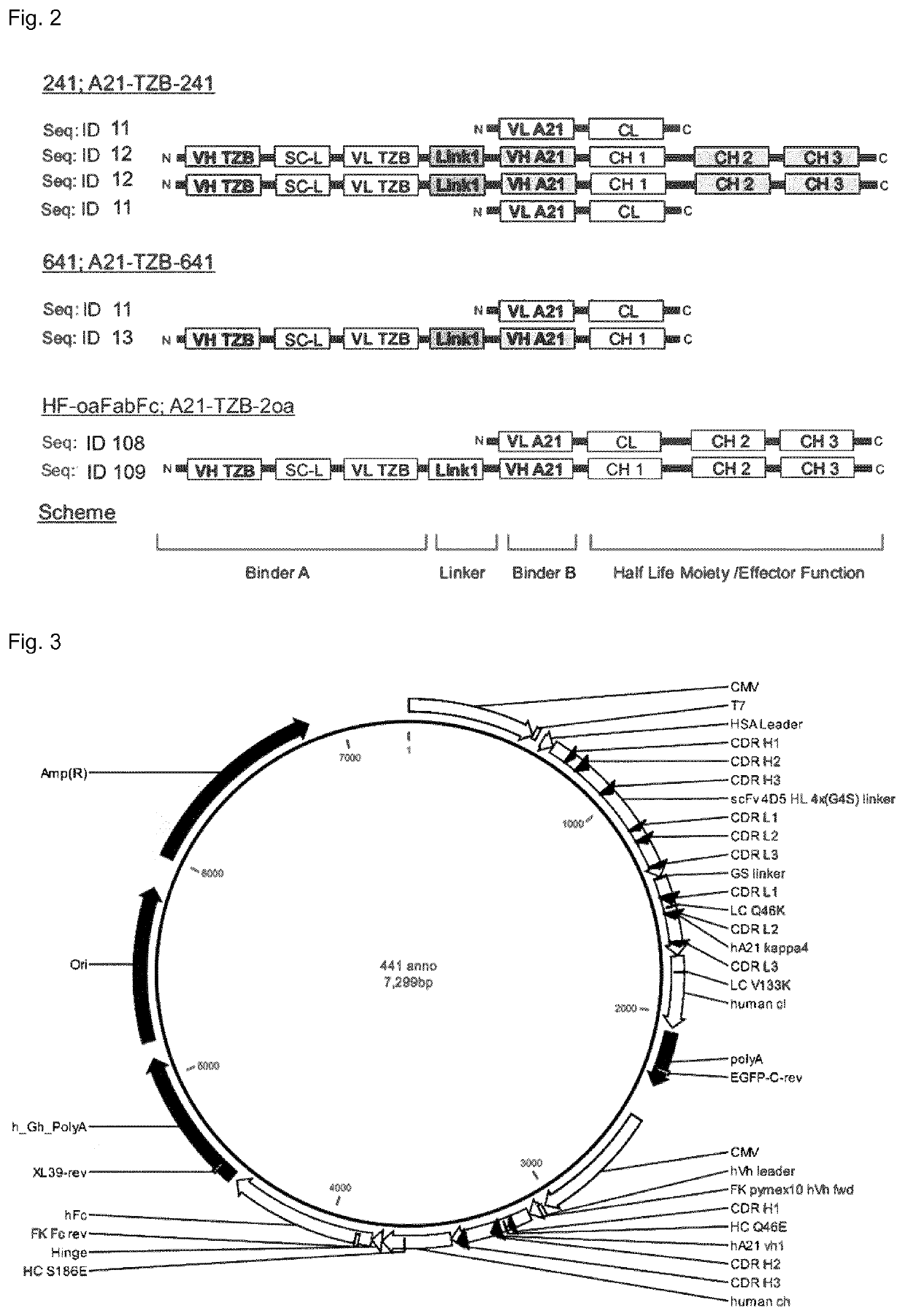Her2-binding tetrameric polypeptides
a tetrameric polypeptide and her2-binding technology, applied in the field of her2-binding tetrameric polypeptides, can solve the problems of incomplete inactivation of her2 receptors, inability to block all, and constructs that do not show the desired pharmacokinetic properties, so as to achieve superior her2 inactivation, increase molecular size, and decrease the mobility of her2 receptors
- Summary
- Abstract
- Description
- Claims
- Application Information
AI Technical Summary
Benefits of technology
Problems solved by technology
Method used
Image
Examples
example 1
Biparatopic Anti-HER2 Binding Agents
[0362]The inventors have generated biparatopic IgG derivatives. In contrast to other available biparatopic HER2-targeting antibodies, e.g. the antibody-drug conjugate (ADC) from Medimmune MED14276 (Li et al., 2016), these IgGs show very strong anti-tumor activity as “naked” binding proteins, i.e., without attached drug (Kast et al., in preparation). Thus, it is believed that these novel biparatopic anti-HER2 IgGs combine the mechanisms of action of trastuzumab plus pertuzumab plus the action of small molecule kinases inhibitors against HER2 in one single molecule. In addition, potential off-target effects of the biparatopic anti-HER2 IgGs are expected to remain far below those of ADC fusions, such as T-DM1 or MED14276, as they can only act on HER2-addicted cells, while ADCs can via their toxin act in many healthy tissue. This opens up the therapeutic windows for new combination therapies. Furthermore, pan-ErbB inhibition by polymerization of HER2 ...
example 2
Enhanced Internalization, Lysosomal Trafficking, and Degradation of HER2 by Revealed Molecule 441
[0389]Microscopy with BT-474 and HCC1419 breast cancer cells For microscopy of fixed samples, cells were seeded at a density of 4·104 cm−2 in p-slides
[0390](Ibidi, cat. no. 80824) in complete medium. On the next day, cells were treated with the respective molecules. After 2 h, cells were once washed with Dulbecco's phosphate buffered saline (DPBS), and fixed by addition of 4% (w / v) paraformaldehyde dissolved in DPBS and incubation at room temperature for 10 min. Next, cells were washed twice with PBSBA+T (DPBS supplemented with 1% (w / v) bovine serum albumin (BSA), 0.1% (w / v) sodium azide, and 0.5% (w / v) Tween-20). Afterwards, cells were incubated in anti-LAMP antibody (Cell Signaling Technology, cat. no. D401S) dissolved at 1:150 (v / v) in PBSBA+T, further supplemented with 100 ng ml−1 2-(4-amidinophenyl)-1H-indo1-6-carboximidamide (DAPI) for 30 min at room temperature. Cells were then wa...
PUM
| Property | Measurement | Unit |
|---|---|---|
| dissociation constant | aaaaa | aaaaa |
| pH | aaaaa | aaaaa |
| pH | aaaaa | aaaaa |
Abstract
Description
Claims
Application Information
 Login to View More
Login to View More - R&D
- Intellectual Property
- Life Sciences
- Materials
- Tech Scout
- Unparalleled Data Quality
- Higher Quality Content
- 60% Fewer Hallucinations
Browse by: Latest US Patents, China's latest patents, Technical Efficacy Thesaurus, Application Domain, Technology Topic, Popular Technical Reports.
© 2025 PatSnap. All rights reserved.Legal|Privacy policy|Modern Slavery Act Transparency Statement|Sitemap|About US| Contact US: help@patsnap.com



